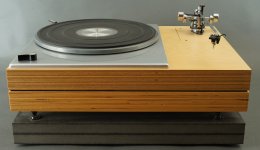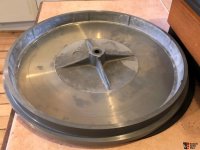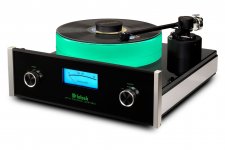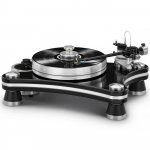In my days no DD table rose to the top. Only 1 we tried was even acceptable when compared to other tables s at similar price.. I think direct drive units are very accurate with quartz PLL and have an extremely low rumble
dave
@burned Fingers
You really don't have to spend 20K to start hearing the difference. I went from a Thorens TD125 MKII with Linn Basik and EVOIII. A GOOD setup mind you. Bought a $3000 VPI with the heavy thick platter (Flywheel). I was shocked and the difference in sound. The music had a solidity to it and pitch definition was just right. VPI's are well worth the money in my book.
You really don't have to spend 20K to start hearing the difference. I went from a Thorens TD125 MKII with Linn Basik and EVOIII. A GOOD setup mind you. Bought a $3000 VPI with the heavy thick platter (Flywheel). I was shocked and the difference in sound. The music had a solidity to it and pitch definition was just right. VPI's are well worth the money in my book.
Which then gives the amplifier back its full power to amplify the hearable parts of the music.Things cannot get fixed after the fact. A HP rumble filter just keeps the LF fundemental from causing the woofer to pump.
dave
Which is a positive improvement.
A record warp, however slight, is not a result of the turntable, it results in amplifier power-robbing woofer pumping, modulating the music, as does loud music feedback from the speakers.
Mike56 should take that into consideration before discounting filters.
Your TD125 deserved a better arm IMHO.@burned
I went from a Thorens TD125 MKII with Linn Basik and EVOIII. A GOOD setup mind you.
jeff
And I've also heard a noticable improvement among turntables without spending 1K or more on them.@burned Fingers
You really don't have to spend 20K to start hearing the difference. I went from a Thorens TD125 MKII with Linn Basik and EVOIII. A GOOD setup mind you. Bought a $3000 VPI with the heavy thick platter (Flywheel). I was shocked and the difference in sound. The music had a solidity to it and pitch definition was just right. VPI's are well worth the money in my book.
Besides, I've never liked Thorens, that jiggly, bouncy suspension on those, and others (AR, Philips, etc) drives me nuts to deal with them.
And as I've said before, there's no need for a bulldozer weight turntable platter for satisfaction.
As well as all the crap added by the table noise to the music. You cannot separate that out after the fact. You are only killing whatever fundamental gets out.Which then gives the amplifier back its full power to amplify the hearable parts of the music.
Yes, the ampifier does have an easier job with the HP, but it does not fix the problem it just deals with par tof the aftermath. A case of closing the barn door after the cow is out actually does something.
dave
There are definitly different approaches, but if i had the money to spend on a new TT, i would get one of the top-of-line Rega’s... there's no need for a bulldozer weight turntable platter for satisfaction.
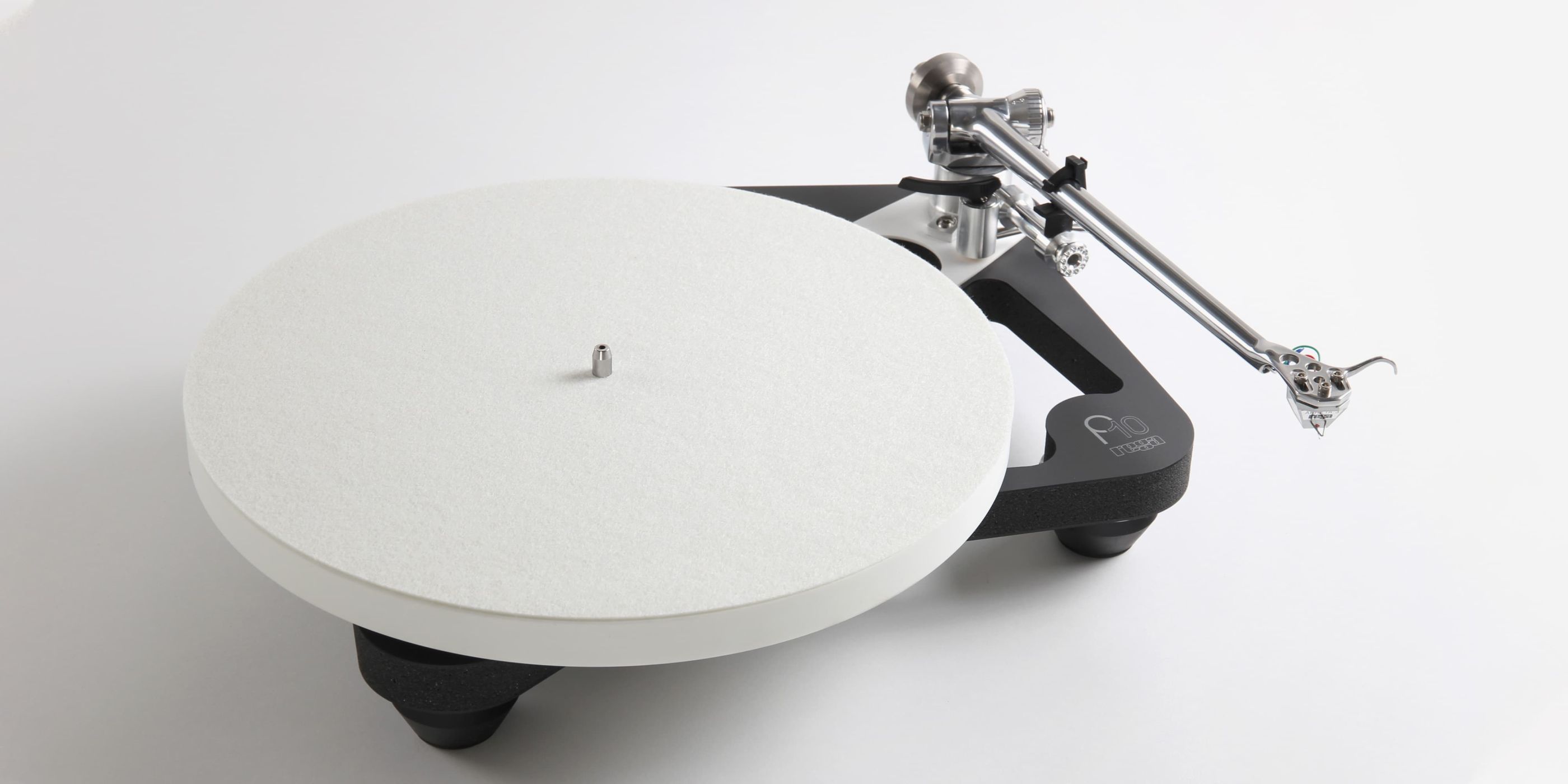
dave
Does a properly maintained Garrard 301 (in a large and heavy, birch-ply plinth) sound different from an excellent condition JVC QL8, even if both use the same (fancy, expensive) tonearm and cartridge?
You bet they sound different. The difference was not nit-picking subtle. It was obvious to me, and to the owner of the two turntables, tonearm and cartridge as well.
At the time, interest in direct-drive turntables was not like it is today. I was hoping I'd like the QL8 better than the 301. Unfortunately, I did not. Oh well.
You bet they sound different. The difference was not nit-picking subtle. It was obvious to me, and to the owner of the two turntables, tonearm and cartridge as well.
At the time, interest in direct-drive turntables was not like it is today. I was hoping I'd like the QL8 better than the 301. Unfortunately, I did not. Oh well.
All very interesting, here my contribution ....😉
In my youth I had a Lenco L-75, which had its qualities and defects. Among the first, it had a heavy and well-balanced chainring, and a motor with great torque and stability. The transmission was a pulley, and continuously variable mechanically. Unique and extraordinary design in my opinion. It came equipped with a small stroboscopic disk (I still have it, to check if my current TT DD Micro Seiki controlled by a quartz crystal oscillator is still spinning at the correct speed, since it does not have regulation or built-in light/display as many others did) , Technics SL 1200 is the classic example) and with a lever that acted as a gear change by placing the pulley on a conical shaft at different points. You could also relocate the optimum speed with the use of the stroboscope and loosening the screws of a slider. Simple, straightforward and efficient.
L-75 is very sought after nowadays (it is very difficult to find in these parts, I sold mine a long time ago and then I regret doing it) to build TT Diy's, you can see in the photo the one that TG built. http://www.troelsgravesen.dk/My-Turntables.htm
On the defect side, the original Lenco L-75 arm was mounted on two V-shaped blades that were mounted in their respective rubber V-blocks, which were damaged but can still be obtained as spare parts and even manufactured. in homemade form. The other "negative" issue was a decoupling system between the weight link behind the pivot and the rest of the arm. This was achieved with an elastic central wire, which over time would wear out and look very bad, but still worked to balance and was still efficient in preventing acoustic feedback. https://www.lencoheaven.net/forum/index.php?topic=13.0
Speaking of the latter, I believe that acoustic feedback is one of the most difficult problems to solve (if not impossible) with turntables, especially if the TT is used in small and/or medium environments and if you want to listen at important volumes. L-75 was one of the best in that regard. You know, the low frequencies of the vinyl picked up by the cartridge are amplified and played through the speakers, then bounce off the edges of the room and back into the TT, vibrating the cartridge and starting a new cycle. And there, the problem can become unsolvable. This will depend on several factors.
If the frequencies captured by the cartridge come from a bad TT design and are transmitted internally (due to a light base, poor damping, etc.), the solution is to change it for a quality, well-built TT. I remember Harksound right now, all plastic, but with the same Thorens floating system on the cymbal/arm set! It worked very well in terms of AR.
This AR occurs when the capsule vibrates at a certain frequency that it receives from the AIR, and the result is a coupling that can be deadly for the speakers and even for the cartridge. You have to lower the volume quickly, or the catastrophe will be inevitable.
Luckily, the remote CR of my amplifier currently has a built-in Mute, so when the volume is high, and I start to hear - and feel in my body - that alert that is perceived as a background howl and gradually increases, I active immediately. But I no longer need to jump out of my chair and lunge at the amp's volume control like I used to, although in both cases the listening pleasure is already spoiled.
So the solution is very difficult to implement, taking the whole system outdoors would be one, but it is a bit practical...
Locating the TT away from the bounces inside the room is not always possible, given the furniture and/or the location of the doors and windows.
DJs get around this with tempered glass booths isolated from the general volume of the track. But at home you can't install a transparent booth..... Or can you? WAF again? Ufff 😆
So between the clicks and pops of vinyl, and the problem of AR (and I say this with nostalgia and at the same time a feeling of disappointment, for being a vinyl lover and currently having two turntables in use, two MM cartridges and one MC , and hundreds of vinyls I love to listen to ) , I have to admit that CDA and other digital media take the top spot for unrecorded artifact-free playback. And the greater dynamic range of the CDA is the advantage that worries me least given the above. Without noise or feedback, with what vinyl offers I would be very happy anyway.
I would like to know of a solution that doesn't involve moving to a huge environment and/or buying an optical cartridge with its dedicated preamplifier (prohibitive prices in both cases, ha), although I'm not sure in this case if AR would be avoided, I think. that although the cartridge will receive the vibrations transmitted by the air, since it is not an electromechanical transducer like a conventional cartridge, there should be no problems in this regard.
In my youth I had a Lenco L-75, which had its qualities and defects. Among the first, it had a heavy and well-balanced chainring, and a motor with great torque and stability. The transmission was a pulley, and continuously variable mechanically. Unique and extraordinary design in my opinion. It came equipped with a small stroboscopic disk (I still have it, to check if my current TT DD Micro Seiki controlled by a quartz crystal oscillator is still spinning at the correct speed, since it does not have regulation or built-in light/display as many others did) , Technics SL 1200 is the classic example) and with a lever that acted as a gear change by placing the pulley on a conical shaft at different points. You could also relocate the optimum speed with the use of the stroboscope and loosening the screws of a slider. Simple, straightforward and efficient.
L-75 is very sought after nowadays (it is very difficult to find in these parts, I sold mine a long time ago and then I regret doing it) to build TT Diy's, you can see in the photo the one that TG built. http://www.troelsgravesen.dk/My-Turntables.htm
On the defect side, the original Lenco L-75 arm was mounted on two V-shaped blades that were mounted in their respective rubber V-blocks, which were damaged but can still be obtained as spare parts and even manufactured. in homemade form. The other "negative" issue was a decoupling system between the weight link behind the pivot and the rest of the arm. This was achieved with an elastic central wire, which over time would wear out and look very bad, but still worked to balance and was still efficient in preventing acoustic feedback. https://www.lencoheaven.net/forum/index.php?topic=13.0
Speaking of the latter, I believe that acoustic feedback is one of the most difficult problems to solve (if not impossible) with turntables, especially if the TT is used in small and/or medium environments and if you want to listen at important volumes. L-75 was one of the best in that regard. You know, the low frequencies of the vinyl picked up by the cartridge are amplified and played through the speakers, then bounce off the edges of the room and back into the TT, vibrating the cartridge and starting a new cycle. And there, the problem can become unsolvable. This will depend on several factors.
If the frequencies captured by the cartridge come from a bad TT design and are transmitted internally (due to a light base, poor damping, etc.), the solution is to change it for a quality, well-built TT. I remember Harksound right now, all plastic, but with the same Thorens floating system on the cymbal/arm set! It worked very well in terms of AR.
This AR occurs when the capsule vibrates at a certain frequency that it receives from the AIR, and the result is a coupling that can be deadly for the speakers and even for the cartridge. You have to lower the volume quickly, or the catastrophe will be inevitable.
Luckily, the remote CR of my amplifier currently has a built-in Mute, so when the volume is high, and I start to hear - and feel in my body - that alert that is perceived as a background howl and gradually increases, I active immediately. But I no longer need to jump out of my chair and lunge at the amp's volume control like I used to, although in both cases the listening pleasure is already spoiled.
So the solution is very difficult to implement, taking the whole system outdoors would be one, but it is a bit practical...
Locating the TT away from the bounces inside the room is not always possible, given the furniture and/or the location of the doors and windows.
DJs get around this with tempered glass booths isolated from the general volume of the track. But at home you can't install a transparent booth..... Or can you? WAF again? Ufff 😆
So between the clicks and pops of vinyl, and the problem of AR (and I say this with nostalgia and at the same time a feeling of disappointment, for being a vinyl lover and currently having two turntables in use, two MM cartridges and one MC , and hundreds of vinyls I love to listen to ) , I have to admit that CDA and other digital media take the top spot for unrecorded artifact-free playback. And the greater dynamic range of the CDA is the advantage that worries me least given the above. Without noise or feedback, with what vinyl offers I would be very happy anyway.
I would like to know of a solution that doesn't involve moving to a huge environment and/or buying an optical cartridge with its dedicated preamplifier (prohibitive prices in both cases, ha), although I'm not sure in this case if AR would be avoided, I think. that although the cartridge will receive the vibrations transmitted by the air, since it is not an electromechanical transducer like a conventional cartridge, there should be no problems in this regard.
Attachments
And as I've said before, there's no need for a bulldozer weight turntable platter for satisfaction.
A high-mass platter of turntable increases rotational stability, thus decreasing wow and flutter. No matter the transmission system, it is always better. The first Lenco chainrings were steel and light, then aluminum and heavy, don't be fooled by what you see on the surface, the rest is below. Here you can see a lot of Diyer's work, many use the platter and the engine of the L 75. There is a job that appears to be two stacked steel B-52/55 chainrings, there are even TTs with linear travel arms! To recreate the view, that's Diy's ! 👍
https://www.lencoheaven.net/forum/index.php?topic=2115.0
Attachments
I can agree with heavier with rotational mass being a powerful way to render wow/flutter issues non-issues.A high-mass platter of turntable increases rotational stability, thus decreasing wow and flutter. No matter the transmission system, it is always better.
However......
How come my lowly Kenwood, with it's (by today's hyped standards) weak direct drive motor, and lightweight 2.5 pound platter spin utterly silent, W/F free (at a tested 0.025%), and with a single ball bearing at the bottom, rumble (if any) below any record noise floor?
Speed is dead-on 33 1/3, and does not change one bit even once the AT stylus hits the first grooves.
A fast hand-spin of the platter at a few hudred RPMs results in utterly silent spinning with an ear almost touching the center spindle.
Answer me that...
And being designed in a plastic cabinet, with it's short linear tracking tonearm, being free of any feedback issues even I crank up the volume with a floor-standing Advent Maestro a mere foot or so away?
I've never had any issues with that machine, other than decades ago replacing the tonearm drive belt.
And no, I don't hear or worry about arm lateral movement noises or interference.
It's silent.
So I stand firm that all the talk about heavy this, and suspension that....... that it's all just discussions and beliefs.
There are too many variables to say that. High mass platters also have significant disadvantages.it is always better.
When we swaped out the standard “heavish” steel platter with a powered copper expoxy platter he had made and precision milled just smoked the stock one. It was WAY lighter. When we did the demo for Mike Remington (NA distrib at the time) he said nothing, you could almost see the smoke come out his ears and shortly after we started seeingLinn upgrade kits.
Replacing the glass platter on my Rega II with a lighter corian one improved things (some tricks you can do with teflon that improve things too.
A TT designer has to juggle a huge number of compromises. How well that set works out can really only be judged by how it sounds. But there are many variables beyonf the TT that affect things so...
My choice above is aided by setting up, listening too, and owning many, many TTs (100s likely).
dave
"Even if I turn up the volume" is a very vague phrase. How many Db/Spl do you apply at a foot distance? What low frequency response do the cabinets have? What is the location of the turntable in the environment? What are the dimensions of it? Are there null points as in 99% of the environments without acoustic treatment? , etc etc. Too many variables to consider.I can agree with heavier with rotational mass being a powerful way to render wow/flutter issues non-issues.
However......
How come my lowly Kenwood, with it's (by today's hyped standards) weak direct drive motor, and lightweight 2.5 pound platter spin utterly silent, W/F free (at a tested 0.025%), and with a single ball bearing at the bottom, rumble (if any) below any record noise floor?
Speed is dead-on 33 1/3, and does not change one bit even once the AT stylus hits the first grooves.
A fast hand-spin of the platter at a few hudred RPMs results in utterly silent spinning with an ear almost touching the center spindle.
Answer me that...
And being designed in a plastic cabinet, with it's short linear tracking tonearm, being free of any feedback issues even I crank up the volume with a floor-standing Advent Maestro a mere foot or so away?
I've never had any issues with that machine, other than decades ago replacing the tonearm drive belt.
And no, I don't hear or worry about arm lateral movement noises or interference.
It's silent.
So I stand firm that all the talk about heavy this, and suspension that....... that it's all just discussions and beliefs.
Perhaps I am setting the bar too high and I consider the phenomenon as if I would be experiencing it in normal listening conditions for me...(80 to 90 DB, I don't think it will go beyond that, I haven't measured it but it is high, and only I do for short periods. I try to take care of my ears.)
I think that my system, by having a very extended low frequency response, can help (negatively) the AR phenomenon that I described...
I've tried the volume at about 3/4 of the way up with a 60/60W receiver punching a pair of 10" air suspension woofers in the room."Even if I turn up the volume" is a very vague phrase. How many Db/Spl do you apply at a foot distance? What low frequency response do the cabinets have? What is the location of the turntable in the environment? What are the dimensions of it? Are there null points as in 99% of the environments without acoustic treatment? , etc etc. Too many variables to consider.
Db levels that vibrate the ashtrays across the room.
No feedback issues at all.
None.
There are too many variables to say that. High mass platters also have significant disadvantages.
When we swaped out the standard “heavish” steel platter with a powered copper expoxy platter he had made and precision milled just smoked the stock one. It was WAY lighter. When we did the demo for Mike Remington (NA distrib at the time) he said nothing, you could almost see the smoke come out his ears and shortly after we started seeingLinn upgrade kits.
Replacing the glass platter on my Rega II with a lighter corian one improved things (some tricks you can do with teflon that improve things too.
A TT designer has to juggle a huge number of compromises. How well that set works out can really only be judged by how it sounds. But there are many variables beyonf the TT that affect things so...
My choice above is aided by setting up, listening too, and owning many, many TTs (100s likely).
dave
Planet 10, I see that you are a very experienced person and you have been "at the dance" so I am glad for that, you are a source of knowledge that not all of us here have.
Questions:
The current Mc Intosh turntables have plates made with unconventional materials, I don't know if they are heavy or not, maybe there are steel balls scattered around inside, I really haven't bothered to find out on the website or ask the representative in my country, whom I know.
I have also heard VPI, they have very heavy "conventional" cymbals, and both deliver a wonderful sound. I would be very happy with any of them. So which one do you prefer and why? Can you explain it to me with " hairs and signs " ? Thank you !
Attachments
Turntables improve with good acoustic treatment(lots of absorption) and low-resonant(well damped sealed alignment) speakers
...
I would like to know of a solution that doesn't involve moving to a huge environment and/or buying an optical cartridge with its dedicated preamplifier (prohibitive prices in both cases, ha), although I'm not sure in this case if AR would be avoided, I think. that although the cartridge will receive the vibrations transmitted by the air, since it is not an electromechanical transducer like a conventional cartridge, there should be no problems in this regard.
What kind of stands are your TT's on? My Linn LP12 is on a 5 shelf Target 5TT, with spikes, and cups, on a wood floor laid on top of a concrete slab. I have no issues with feedback and the stand is light enough to satisfy Linn's design requirements. It has a great sense of rhythm and allows the Maggies to put out their bass slam very well.
Some turntables like heavier mass stands. I used to have a massive stereo stand where my old Dual belt drive did great but the Linn sounded pretty boring. Conversely, the Dual didn't like the Target stand.
Yeah, the optical cartridge is indeed an interesting concept.
IIRC some kind of delron-type material. Some use brass weights around the perimeter (cylinders) to increace rotational momentum.The current Mc Intosh turntables have plates made with unconventional materials
Me prefer? If i had the money the Rega 10 i posted above (and a rhird pary collar to allow arm height adjustment0. If i could spend that much i might be able to reach for one of those new fangled cartridges where a laser is used to measure the deflection of the cantilever instead of the usual magnetic field (strain-guage excepted).
Nut i am sure there are many TTs that would satisfy my needs.
dave
Thanks wiseoldtech, i didn't intend anything i wrote to discount filters, in fact i have a switchable rumble filter (rolls off below 20hz in the hypex plate amp http://www.troelsgravesen.dk/FUSION-BI-AMP-DSP.htm ) through my bass speaker amps, but i don't see pumping woofers either way and i don't use it, my point was that the effects elsewhere in the frequency range from such things should be avoided if at all possible as they will for sure be audible and my experiments and measurements of the same confirm that to me, and removing them performs and sounds better, so that's what i believe one should concentrate on, best, MWhich then gives the amplifier back its full power to amplify the hearable parts of the music.
Which is a positive improvement.
A record warp, however slight, is not a result of the turntable, it results in amplifier power-robbing woofer pumping, modulating the music, as does loud music feedback from the speakers.
Mike56 should take that into consideration before discounting filters.
Its worth having a careful look at what Mr Baker at Origin Live does, a thorough read of his website will provide all sorts of interesting information and his kit is well thought of...........There are definitly different approaches, but if i had the money to spend on a new TT, i would get one of the top-of-line Rega’s

dave
- Home
- Source & Line
- Analogue Source
- Can one turntable sound better than another?
